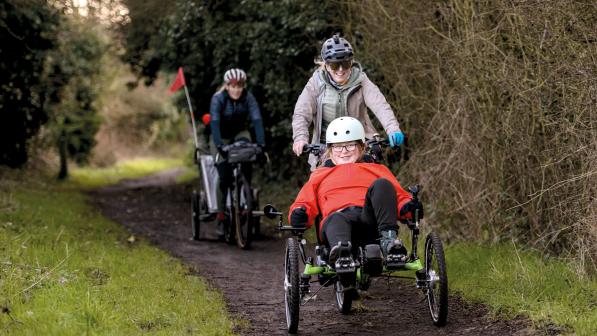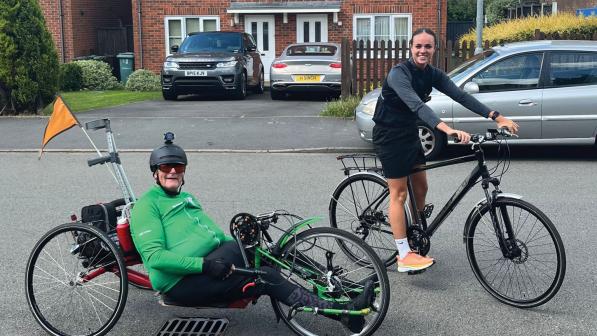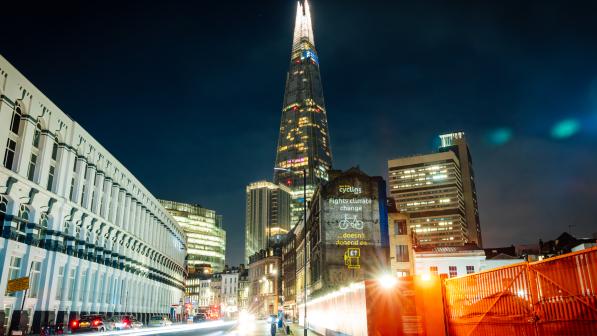Great rides: A handcycle up Kilimanjaro

Four in the morning: a late start for climbing a mountain as high as Kilimanjaro. My head throbbed and the desire to vomit spoiled any urge to eat breakfast.
I thought of the long scree slope ahead of us. Our ride to the crater rim would be extra challenging, given Steve’s limited sight and my own inability to walk.
Steve Bate and I are long-time friends and Paralympic cycle teammates. We had shared years on the medal-chasing treadmill and both won Paralympic golds. But at times we had lost connection with things that really mattered to us. Wild places. Perspective. Adventure.
We had taken one big trip together after the Rio 2016 Paralympics, cycling the rough trail of the Carretera Austral, 1,200km through Patagonian wilderness. It was a post-Paralympic depression antidote.
Now, perhaps, we were both seeking another remedy of sorts. Steve was attempting to mountain bike up Kilimanjaro and I was trying to do it on a hand-cranked trike.
Mountain cycling
The first people to reach the summit of Kilimanjaro on mountain bikes were the Crane cousins in 1985. If I had researched more thoroughly, I may have found this Cycling UK forum comment: “Saracen sponsored Nick (yes, him off the telly) and Dick Crane to ride (more like carry) some Saracen MTBs up Kilimanjaro in the ’80s…” And I’d have focused on the world ‘carry’.
My optimism came from the knowledge that various paraplegics had summited the mountain. In 2009, American Chris Waddell became the first paraplegic man to reach the top of Kilimanjaro on a handcycle.
The same year, I met another paraplegic cyclist in the United States just back from the mountain. He had reached the crater rim and generously gave me a go on his special handcycle.
It had huge balloon tyres for tackling the scree, and even the sight of it triggered in me excited ideas of what might be possible with a piece of equipment like that.

Scaling mountains was something I did before becoming paralysed. While forever an adventurer at heart and still motivated by the beauty of our natural world, I don’t have a bucket list; Kilimanjaro was not on my radar.
However, a series of connections and synchronicities relating to Africa’s highest mountain led to the idea taking shape. One of these catalysts was Martin Hibbert, who was paralysed in the Manchester Arena bombing.
I accidentally got involved in his Kilimanjaro project when his team were training for their climb by trekking Scotland’s West Highland Way. Martin was unwell and I became his stand-in, using a special wheelchair called a Mountain Trike.
It was a unique experience for me to be among rocks, trees and heather. It opened my mind to new technology that can enable so much. Soon after, I encountered a new design of handcycle from Inspired Cycle Engineering, which I was asked to trial.
It was another game changer. I shed tears of joy across Scottish forests and beaches, enjoying terrain that had long been inaccessible to me. In the three decades I have been paralysed, innovation and design advances have been immense, and the possibilities that they enable are as equalising as they are exciting.
Nerves before Nairobi
Flights to Nairobi were booked and the logistics all organised. Yet I found myself feeling uncertain about the objective before us. I was unusually non-positive in my language.
“We’re trying to climb Kilimanjaro,” I said, noticing a weakness behind how I said it. Did I have a lack of belief or a measured respect for a mountain high enough to cause acute mountain sickness? Or maybe it was partly fear?
I’ve previously survived cerebral and pulmonary oedema, and I knew there are typically a handful of altitude-related deaths on Kilimanjaro each year.

I was aware of my dependence on both the technology and the team. The trike would have to be reliable and sturdy to manage such extreme conditions. The team would need to be resilient and adaptable, ready for anything. In addition, how would Steve’s riding pace dovetail with my own slow crawl up the slopes alongside those walking?
Our team was wonderfully diverse, ranging in age from 12-year-old Amelia to 55-year-young Kevin. Jannie and Bow had never climbed a mountain and were on deeply personal journeys.
Our filmmakers, Mike and Sherrill, had their own unique challenges beyond gathering footage: Mike had a recent diagnosis of narcolepsy, meaning regular naps and sensory zone-outs, while Sherrill had been training hard to improve her fitness.
We all met for the first time in Tanzania, quickly bonding over our captivation to explore the volcanic slopes of the world’s largest free-standing mountain.
The ascent begins
Altitude and mountain sickness seemed the biggest obstacles to a successful climb, so we planned a longer ascent via the Rongai route. It is the only route on the northern side of the mountain, with the added appeal of being a little more remote, rarely visited by hikers.
Our team of eight required four porters per person, according to the National Park rules, with guides and cooks on top of that. Rongai Gate was our starting point at 6,400ft, in the middle of a rainforest.
We met at the head of the trail among the dense, lush vegetation, making quite a crowd. As we set out, I felt buoyed and bamboozled by the unfamiliar names, beaming smiles and positive energy of our African team.
We were missing Steve, however. His fat bike was still in a Manchester airport terminal, so he had stayed back to figure out when it might arrive and what to do if it didn’t.
I was generally surprised at the rideability of the trail and the capabilities of the trike. A narrow flight of steps by a waterfall needed a piggyback, but otherwise we moved quite easily. The forest transitioned into moorland grasses, the next of five biodiversity zones we would encounter.

Arriving at our first camp, Simba, we were welcomed by our team dancing and singing “jambo”, a Swahili greeting. It was to become a tradition, which we loved: being surrounded by our team in dance and song to celebrate the end of each day’s hike.
For the next stage to Kikelewa camp we adopted the mountain mantra of “pole, pole”, meaning “slowly, slowly”, an antidote to altitude gain. The size of the boulders and the crevices to negotiate required my new friends to be strong both in mind and body.
Musa, Amadeu, Lucas and Joel – two at the front and two at the back – were a steadfast team. I pedalled and they frequently negotiated my wheels over giant boulders.
I was astounded at what we were moving over. With spectacular ground clearance compared to other handcycles, and fitted with three Schwalbe Jumbo Jim fat tyres, the ICE trike felt as great and graceful as the elephants we had observed the previous week.
Yet it wasn’t long before the effects of altitude started to kick in. Bow felt sick, and many of us lacked appetite, had headaches or felt a little breathless. Day three would require only a few hours of hiking to the next camp, but we were a little sluggish in our progress and grateful to arrive before lunchtime. We took the time to rest and adapt to the thinner air.
Kibo camp
Later that afternoon, anxiety about Steve finally dissolved as he rolled into camp. Celebratory singing tugged us from our tents. We emerged to greet him cycling in on a locally sourced mountain bike.
It had thinner tyres than his fat bike, giving him less room for error if he didn’t see an obstacle. He had practically sprinted up the trail to catch us up, demanding that he and his team of porters adapt even more rapidly than us to the gain in altitude.
Happy to at last be together, there was an optimistic vibe as we tackled the next 10km and another 1,000m of ascent.

Steve pedalled and patiently waited, enjoying moments as the rest of us steadily plodded. The vast volcanic cone of Kili was clear of cloud, high above and luring us onward. It changed perspectives of the journey ahead: from tame to tall, gentle to giant, mouse to lion, easy to insurmountable.
That night, at 4,800m and our final camp at Kibo, we did our usual health check with our guide Luhi. We measured our blood oxygen levels, pulse rates and reported a number out of 10 as to how we felt.
Steve gave himself a three. It seemed a very low score for a man used to suffering. He looked pale, and soon left the tent to throw up. It was the second evening Bow hadn’t made it to the dinner table, and I projected to the next day, wondering how we would all manage.
But our head guide wasn’t deterred. “You are doing great!” Luhi smiled. “So tomorrow, one team, one dream, non-stop, to the top”. His motivational words were lost on us as, pale faced and with heads pounding, those of us who could forced ourselves to eat.
To fall asleep that night, I found myself using the trick of curiosity to ease the angst of the unknown. I cosied into the billows of my sleeping bag and thought: “I wonder what will happen…?” I felt better at the spill of dopamine caused by being open minded and filled with wonder.
The summit bid
Feeling physically rough but mentally ready, we set out for the summit. As the sun rose behind us, the scree looked more aggressive. We progressed very slowly and, despite the focus and pressure to keep moving, I called a pause. A sunrise has to be appreciated.
We sipped water and looked out in awe. To the east, the jagged ridge leading to neighbouring Mawenzi Peak was a dramatic black shadow against a pink and orange dawn.
The vast volcanic cone of Kili was clear of cloud, high above and luring us onward
I breathed in the sight, the height, the beauty of the inversion, clouds far below coating the East African plains. I imagined the power of the elephants and the ferocity of the lions far below, powering us onwards and up.
The terrain became steeper, then finally it was too vertical for scree to cling to the mountainside. Only dust and slabs of rock remained. As I looked up, my strength of mind wavered. “How?!” It appeared impossible to navigate unassisted.
I watched Steve pass me, his bike carried on his guide’s back, and wondered whether it was time to call a stop. My African team were determined. Their focus strengthened and they began to piggyback me. They rotated me from tall Maasai Lucas to shorter Chagga-tribe Joel. As I gripped tight, I felt their bones, their strength and sure-footedness.
Inch by inch, we reached Gilman’s Point, the first official summit on the crater rim. It was still too narrow to ride, so the piggybacking continued part way along the ridge towards the second official summit at Stella.

I was astounded by my team’s constant smiles and resilient intent, worried for their backs but flowing with their plan. Finally I was reunited with the comfort of the ICE trike. It felt luxuriously comfortable, and the rideability of the final stretch of ridge was both a relief and a surprise.
The elation of reaching the cairn of Kilimanjaro’s main summit felt surreal. The dizzy height of 5,895m (19,340ft) felt wonderful in many ways. It wasn’t quite as we had envisaged it as there were just three of us from the original eight.
Kevin, Steve and I hugged through the puff of our warm jackets, emotion flowing. While doing so, we got news that Bow, Amelia and Sherrill had turned back. The altitude was harsh. Jannie and Mike were still climbing.
High above the big African landscape, with a view of the shrinking glacier and a handful of other climbers hungry for denser air, we held each other in a poignant moment. Yet it was no place to languish. The summit was only halfway.
An easy pedal down the ridge took us back to piggyback land. Whenever the going got tougher, the team voted for the main man: “You are Maasai Lucas. You drink blood. You are strong to piggyback Karen here.” He took me steadily and safely back to the scree.
In billows of dust, the trike descended the loose stones without tail-ending. It was faster down than I had imagined. Lower down, Steve and I rolled on down the rocky trail with relative ease. Bumpy, tricksy and with never a dull moment, we arrived a day later at Marangu Gate, celebratory, oxygen-replenished, a little bruised of body but rich in heart and mind.
Our journey to the roof of Africa was made possible by the fantastic team of porters, cooks and guides at African Scenic Safaris. Thank you for bringing all your strength, singing and best feet forward.
Cycle magazine
Every two months Cycling UK members receive Cycle magazine, filled with interesting and informative articles, news and reviews for all cyclists.
Members can read the magazine in full online; non-members can read selected highlights.



